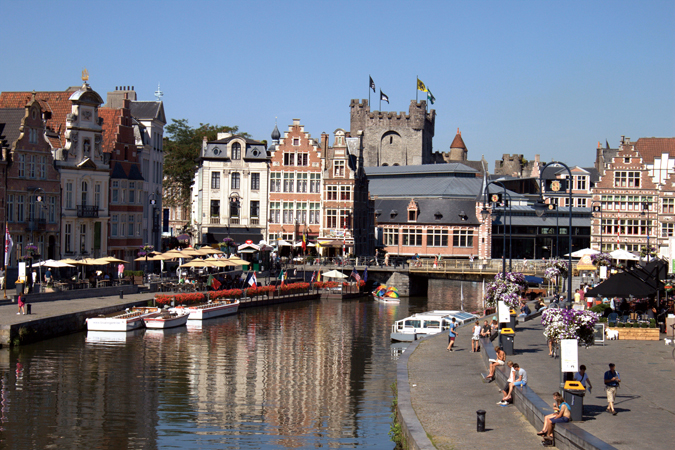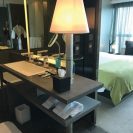Ghent – also spelled as Gent – is Belgium’s 3rd largest city, falling in the Flanders region, where Flemish (akin to Dutch) is the spoken language. A 56-minute train ride will take you directly from Brussels Airport to Gent Sint-Pieters Station. A century ago, Ghent hosted the 1913 World Exhibition, for which they renovated most of their historical buildings and made additions to some existing ones – so that it looked even more medieval than it did during the Middle-Ages! Much of that old-worldly charm can still be seen today. Picturesque town squares, remarkably well-preserved medieval architecture, the Opera House and several colorful festivals including, Europe’s biggest festival has earned Ghent a befitting moniker, “European capital of culture”. And I would have paid no attention to this city at all, if it weren’t for my friend residing in Ghent. Maryam, amongst many other things, is a cultural-host, an active couch-surfer, a good photographer, and knows the city as well as any true Gentenaar. Thanks to her, I was saved from falling into tourist-traps and enjoyed the true essence of Ghent in less than two days.
Flemish Dinner and Ghent at Night
‘De Lieve’ is one of the few traditional places in Ghent serving Flemish food. Like many other establishments, the place is a throwback in time, but with good food. You are given a handwritten menu in Dutch only, so you will need to ask the host for advice. We ordered mussels, and a bowl of the irresistible Belgian fries – neither of which you should miss.
After dinner, we decided to walk through Ghent. The Graslei on the river Leie is the city’s most beautiful place, and seems like everyone in town comes here to chill. The view of the rows of historical buildings reflected in the river is mesmerizing. I am told Ghent turns into a visual spectacle during the Light Festival, which is held every three years, with their award-winning lighting plan. Heading further on, I was awestruck by the imposing medieval structure – Castle of the Counts (Gravensteen), a sight that is eerily breathtaking in the dark of the night and the only remaining medieval castle in the Flanders.
It was soon evident that every building and nook in Ghent has a story. I was fascinated by the Little Toll House, the ‘narrowest house’ on the Graslei; the smallest pub,‘t Galgenhuisje, which means, and used to be, a gallows house; and a hole-in-the-wall jazz club, to name a few. I even spotted a string suspended overhead with several shoes dangling from it. Maryam explained that folks believe leaving your shoes behind will ensure your return to Ghent!
Must see in Ghent
Ghent has an endless list of places to see, but of course I could not visit them all. If time is sparse, and you are on your own, a free USE-IT (www.use-it.travel) map, well illustrated and packed with tips and trivia, comes very handy.
Most of the main attractions, are all within walking distance of each other. Belfort (Belfry) – the medieval watchtower, with a dragon on the top, is Ghent’s proudest symbol of independence. St Bavo’s Catherdral – the Gothic structure is known for its famed masterpiece Adoration of the Mystic Lamb, painted by the Van Eyck bothers in 1432 and a Romanesque crypt below.
Then there are quaint buildings like ‘t Toreken, a former guildhall with no stairs. Inhabitants originally used ladders, but it now has an elevator, albeit, the slowest in Belgium, to avoid any damage to the monument. A 13th century grim fortress – the Castle of Gerard the Devil, named after its legendary dark haired owner, Gerald Vilain, whose life is shrouded in mystery. The monumental St Michael’s Bridge gives you the most panoramic view of all the surrounding landmarks, and some great shots to put in the picture album.
Beguinage of Ghent
The Flanders region has thirteen Beguinage, of which three are located in Ghent, and are all listed as UNESCO World Heritage sites. The most beautiful and well-preserved is the Small Beguinage in Lange Violettestraat, founded in 1235. Like the others, the Beguinage has long lost its original function, and the last beguine of Ghent died in 2005. The red brick houses with white-washed front garden walls and little green gates are now leased to the local community. As per tradition, the place still opens from 6.30am to 10.00pm only.
Belgian Waffle and Hot Chocolate
An absolute must-have in Ghent is Belgian waffle and coffee at ‘Mokabon’ and a cup of hot chocolate at ‘Huize Colette’ – both are specialty houses. Mokabon is retro, and their warm waffles, sprinkled with icing sugar, are unforgettable. According to Maryam, and you will agree subsequently, Hiuze Colette co-owned by Ottelien and Aline, serves the most delicious cup of fresh hot chocolate in town.
Tierenteyn Mustard Shop
Tierenteyn (B-2, Groentenmarkt 3) mustard is renowned beyond Ghent and coveted by top chefs. The local mustard is traditionally prepared, and the recipe is a family secret. It is the most pungent mustard I have ever tasted, and their little jars make perfect souvenirs.
Stroll through Werregarenstraat
Werrengarenstraat would mean nothing to you, or even to the localities. Maryam, who I discovered has the coolest pick of places to show guests, of course knows where to find it. It’s actually an alley called ‘Graffiti Street’, where street artists can legally let themselves go berserk with spray cans. Tourists, especially those who are artistically inclined, will love this colorful place, where pictures are ever-changing.
Belgian Chocolate and Cuberdons
Maryam recommended Van Hecke chocolaterie for the famous Belgian chocolates we all love. Cuberdons or neuzekes are quaint purple, sugary sweets shaped like little cones that have been around since 1870. I’m a little mortified to admit I didn’t taste them, but Cuberdons have a short shelf-life, so you can taste it only in Ghent.
Festivals of Ghent
If all the medieval history was not enough to lure tourists, Ghent turns even more charismatic with its many festivals. Annual festivals include: the Jazz Festival (10-19 July); the popular Gentse Feesten (18-27 July) with over 2 million visitors in attendance; the Gent Festival of Flanders (13-27 September) when Ghent transforms into a music-haven; the Patersholfeesten held in the oldest quarter of the city in August; and then some more.
You can find more information at www.visitgent.be. Photographs by Maryam Aljoaan.








